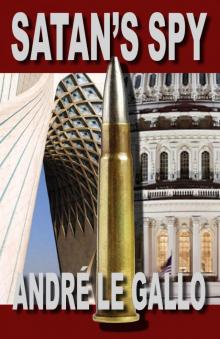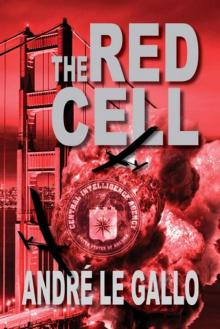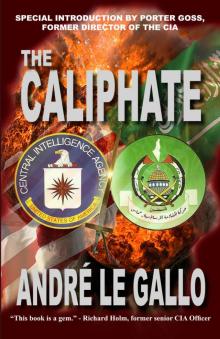- Home
- André Le Gallo
Satan's Spy (The Steve Church saga Book 2)
Satan's Spy (The Steve Church saga Book 2) Read online
SATAN'S SPY
André Le Gallo
Also by André Le Gallo
The Caliphate
The Red Cell
SATAN’S SPY
Copyright © 2021 André Le Gallo
Original copyright © 2014
All Rights Reserved
Published in the United States of America
by D Street Books
a division of Mountain Lake Press
Cover design by Jutta Medina
This is a work of fiction. Any resemblance to real persons, living or dead, except for certain historical figures, is unintentional and coincidental.
No part of this book may be reproduced in any form or by any electronic or mechanical means, including information storage and retrieval systems, without permission in writing from the publisher. The only exception is by a reviewer, who may quote brief excerpts in a review.
To Cathy, Thérèse and Craig,
Elise, Brittany and Preston
for your support and encouragement
Contents
Foreword
Introduction
1. Manama, Bahrain
2. Tehran: Detention Center for Revolutionary Guard Corps
3. Tehran: Early January 1979
4. McLean, Virginia: The Present
5. Marin County, California
6. Langley, Virginia: CIA Headquarters
7. Langley: National Clandestine Service
8. Tehran: Former American Embassy Grounds, Mousavi’s Office
9. Alexandria, Virginia: Old Town
10. Langley: Office of the Director
11. Tehran: Hotel Tehran, Chamber of Commerce Breakfast
12. Washington: Four Seasons Hotel
13. Shemīrān, Iran
14. Tehran: Imam Khomeini International Airport
15. Navārān, Iran
16. Tehran: The Persian Esteghlal International
17. Tehran: Canadian Embassy
18. Langley: Director’s Office
19. Tehran: Mousavi’s Office
20. Washington: House Permanent Select Committee on Intelligence
21. Tehran: Farah’s Apartment
22. South Tehran
23. Tehran: Canadian Embassy
24. Tehran: Al Quds Safe House
25. Tehran: National Computer Center
26. Tehran: Tuesday
27. Tehran: Ministry of Intelligence Compound
28. Tehran: Esteghlal Hotel
29. Washington: Tribune Building
30. Washington: White House Situation Room
31. Tehran: Ketaki Restaurant
32. Tehran: Swiss Embassy, U.S. Interests Section
33. Tehran: Al Quds Safe House
34. Tehran: Grand Bazaar
35. Tehran: Farah’s Apartment
36. Tehran: Friday-Saturday
37. Tehran: Al Quds Safe House
38. Tehran: Swiss Embassy
39. Persian Gulf: Aboard the U.S.S. Allen Dulles
40. Washington: U.S. Capitol Building
41. Tehran: President’s Office
42. Outskirts of Tehran
43. Tehran: Crossley Residence
44. Tehran: Farah’s Apartment
45. Tehran: Crossley Residence
46. Langley: Director’s Office
47. Yazd, Iran
48. Yazd: Yazdi House
49. A Street in Tehran
50. Yazdi House
51. Persian Gulf: U.S.S. Dulles
52. The Qanats
53. The White House: Oval Office
54. On the Road to Shiraz
55. Shiraz, Iran
56. Andrews Air Force Base: CIA Hangar
57. Firuzabad, Iran
58. Qashqai Camp, South of Firuzabad
59. Nayband Marine Coastal National Park, Iran
60. Manama: U.S.S. Dulles
61. Zagros Mountains, Iran
62. Zagros Mountains
63. Manama
64. Zagros Mountains
65. Persian Gulf: U.S.S. Dulles
66. Persian Gulf
67. Tehran: Mousavi’s Office
68. Persian Gulf
69. Mousavi’s Office
70. The White House: Oval Office
ACKNOWLEDGEMENTS
ABOUT THE AUTHOR
Foreword
André Le Gallo’s Satan’s Spy is a refreshing break from the usual pattern in American pop culture when dealing with American espionage. We are spared the usual cartoon of bumbling incompetence or anti-Constitutional malevolence. Rather, here we get to see a CIA that, despite its fair share of human failings, is generally populated by conscientious, capable citizens. We see a fair measure of courage and intelligence, along with some lesser virtues and an occasional vice. And we see how the agency must operate in the dangerous and morally ambiguous world created by clashing personalities, policies, cultures, and politics.
Le Gallo is able to do this because he has been there. A career case officer, the details of his plot are at times vaguely autobiographical, adding operational realism to the twists and turns of his story line.
And what a story line! Le Gallo allows himself to paint boldly, with bright colors and a wide brush. Beginning with a terrorist attack in a Gulf Hotel and ending with a daring escape attempt at sea, Satan’s Spy more than fills its quota for adventure. There is a botched Iranian election, cyber combat, and even an exquisitely timed act of God to complicate events.
But with all of its twists and turns, and even with the occasionally unexpected plot event, Satan’s Spy is anchored in reality: a dangerous Iran with aggressive ambitions and deeply felt internal dissent; a cyber menace that threatens catastrophic destruction; an American intelligence community struggling with democratic demands for transparency even while dependent on secrecy for its success. As that reality seems to shape and reshape itself daily in the Middle East, Satan’s Spy gives its reader more than a small edge in penetrating the meaning of current events. Clearly Satan’s Spy does not try to say it all, either about global crises or about espionage. But it does lift the veil a bit and that’s a service, especially since it does it in a way that both informs and entertains.
—General Michael V. Hayden
Former Director, National Security Agency
Former Principal Deputy Director of National Intelligence
Former Director, Central Intelligence Agency
Introduction
“Are you keeping Steve and Kella in your new novel?” I was asked at a book signing for my first novel The Caliphate. When I said I was, the middle-aged man who had asked the question said, “Great! That Kella is a beautiful girl!” His wife pulled on his sleeve to have him sit down and, in a stage whisper, said, “Arthur, she is only a fictional character.” With encouragement like that, I had no choice but to revive Steve and Kella for Satan’s Spy.
“Write about what you know” goes an old saying, so the background tapestry for Satan’s Spy is drawn from personal experience. Intelligence operations do not exist in a vacuum, and the story provides a glimpse into some of these external factors: the friction between the CIA and the Department of State, the professional and competitive culture in the world of clandestine operations, and the now long running Iranian hostility toward the United States. We know that politics no longer stops at the water’s edge from the public partisan wars over foreign policy that the media serves up, and participates in, daily.
For Iranian atmospherics, I drew on one of my most memorable tours with the CIA, which took my family and me to Tehran at the outset of the 1978–79 Revolution.
Since our house was near a mosque where the rioters
would assemble after the daily curfew, each night was “Ground Hog Day.” Punctuated by the full-throated “Allahu Akbars” of our neighbors on their rooftops, crowd noises usually peaked around 11:00 p.m., overpowered an hour later by the clanking of Centurion tanks followed by shots and silence until the next day. The following morning our Iranian neighbors’ children would knock on our door to ask our children to come out and play. One night I found a note under the door, which threatened to kill my family if we were not all out of Iran by December 1st.
The roadblock scene is not atmospheric; it is based on an actual event.
The friction between the CIA and the State Department’s Foreign Service Officers goes back to the beginnings of time. Although most FSOs are professional, comfortable in their skin, and accepting of the CIA’s mission to collect “otherwise unobtainable information,” there are others who see CIA reporting as threatening to their careers and who suffer from clientitis.
As far as the role of the intelligence oversight committees of Congress, current events have shown that some of its members prefer partisanship to the national interest.
One day we may learn that the CIA is currently running high risk operations in Iran that are similar to Steve and Kella’s adventure.
—André Le Gallo
Marin County, California
December 2011
1. Manama, Bahrain
Steve Church was jogging on the treadmill in the fitness center of Manama’s iconic Panorama Hotel when his cell phone beeped. The Al Jazeera newscast from the flat-screen TV in front of the aerobic equipment showed Iran’s sulfurous but always entertaining president vigorously defending his country’s right to build a nuclear weapon that, he insisted, Iran was not building. While mentally incorporating the Iranian’s belligerent tone into a presentation he was scheduled to make later that day to the Bahraini Special Forces, Steve checked his phone but did not answer it. It was the second time this morning that the special assistant to the CIA’s Director of the National Clandestine Service, Thérèse LaFont, had tried to reach him, but he wasn’t sure whether he was ready for another dance with the NCS bureaucracy.
He returned his attention to the news when a series of muted popping sounds immediately refocused him on his surroundings. None of the other four ambitious souls in the small gym reacted, hypnotized by the digitized product of their work—heart rate, distance, calories, heart rate, distance, calories—and on the TV now showing a student demonstration in Tehran. Steve stepped into the carpeted corridor but heard nothing more. Back inside, he took a swig from his water bottle and decided the sounds must have come from the television.
He resumed his running mulling over the wording for his speech. As a member of the Gulf Cooperation Council, Bahrain had recommended that the GCC create a Rapid Reaction Force. The other GCC members, Kuwait, the United Arab Emirates, Oman, Dubai, and Saudi Arabia, favored the idea but were worried about Iran’s reaction. Steve, who had successfully introduced his employer, the Northern Virginia-based consultant company West Gate, into Morocco now saw a similar opportunity in the Gulf.
This time the sounds were unmistakable: muffled screams and gunfire. His gym mates, now looking confused, stopped their exercises. Steve jumped off the treadmill and ran to the corridor heading for the stairs. Wiping his brow and running the towel hanging from his neck over his short brown hair, he stopped and ran back to the gym before reaching the stairs.
“I don’t know what’s going on but everyone should leave the hotel – sounded like shots,” he said from the doorway raising his voice over the TV. His six-foot-one runner’s build looked fit without being imposing; nevertheless, his audience was attentive. “There must be a delivery entrance in the back, out through the basement,” he said. He then ran back toward the red exit sign over double doors leading to a stairwell, this time with the small group in tow.
Before he could open the door, a younger man who had been in the gym caught up with him and handed him his bag. “If we’re not coming back,” his new best friend said, “you probably want this. I saw you had a phone in there.” Steve nodded politely, retrieved the phone and a couple of personal items that would fit in his pockets, dropped the bag, and started running down the metal steps.
One floor down, shouting behind the door that led into the lobby made Steve stop. Urging the group to continue on down the stairs without him, Steve cracked the lobby door open, conscious of the puzzled looks from his group and wondering himself why he simply didn’t follow his own advice and get out.
Partially hidden by a massive elevator tower twenty feet away, the spacious lobby was sunlit from skylights fifteen floors up looking down on a central atrium. Walkways overlooked the lobby and provided access to guest rooms. In a crouching run and glancing from side to side, Steve left the safety of the stairwell to peer from behind the elevator tower.
Men and women’s shoes, shirts, and other items of clothing littered the lobby. A red streak the width of a body ran through the middle of the confusion. Two people lay just beyond Steve’s hiding place. One in a hotel uniform was motionless and on his back; the other, in slacks and a blazer, faced away from him moaning softly, blood seeping onto the floor from under his body. Two back-packs seemed abandoned, one near the reception desk and the other by itself in the middle of the lobby. Booby-trapped IEDs left for unwary first responders, thought Steve.
Two men in camouflage pants with backpacks and assault rifles ran across the white marbled floor toward a large seating area filled with zebra-striped chairs and shiny red sofas. One of them, dressed in crimson Harvard T-shirt, stopped and fired at a heavyset man in Bermuda shorts and a golfing shirt trying to reach a side door. Bullets punctured the man’s shirt and pierced his soft flesh before he went down out of Steve’s sight. Inside and to the right of what remained of the glass front wall, a bearded young man with a black bandana around his head stood behind the concierge’s chest-high counter and scanned the street in front of the hotel, the muzzle of his AK-47 leading his gaze back and forth. Glass shards littered the floor around him.
Looks like Mumbai all over again, Steve thought, remembering the 2008 terrorist attack against the Taj Mahal Hotel. There, it had taken the local police and army hours to show up while the terrorists went from room to room on a killing spree.
Still crouching, he retreated to the stairwell from which he had emerged, and pushed the door open carefully while looking back toward the lobby. The stairwell lights were now off, but a weak battery-powered emergency lamp gave off some light.
Have the authorities cut off the power? Or do the terrorists prefer darkness for their murders?
He reached for his phone wondering whether Bahrain had an equivalent to 911. Instead, he tried zero and reached an alert operator who promised to call the police. Steve gave him his own number and pocketed the phone before he heard the door from the lobby begin to open.
He barely had time to flatten himself against the wall behind the door before the Harvard shooter stepped through and, after a cursory look into the dimly lit stairwell, walked quickly toward the stairs going up. When the door closed, Steve rushed him from behind and tripped him. As Harvard fell forward, he squeezed the trigger of his AK-47, the deafening sound of 7.62 mm bullets bombarded Steve’s eardrums, and the sharp smell of gunpowder penetrated his lungs. The man’s head hit the first step, and his body was limp when Steve stepped over him to strip him of his weapon and ammunition.
Steve quickly staged the body at the bottom of the steps, ran up around the turn past the first landing and loaded a new thirty round banana clip. He shot the emergency light out and waited in the pitch darkness for Harvard’s pals. His heart was racing, and he wondered why he just didn’t get the hell out, following his friends from the fitness center.
Before he could change his mind, the door opened again allowing a spear of light to reveal Harvard’s body for an instant. Steve stayed crouched and hidden as one man stepped into the stairwell below him and quickly moved to the left
toward the wall while a second man went to the right toward the down staircase. Steve regretted that he hadn’t fired immediately. His eyes were more adjusted to the darkness and, wanting to take advantage of the night-vision he had acquired over the previous few minutes, was preparing to fire at one of the two men when melodious ring tones coming from his pocket with the impact of a ten-alarm fire broke the silence and sent Steve’s heart into a somersault.
The sound triggered shooting from the three men, all within twenty feet of each other. Steve, whose weapon was already pointed at the terrorist on his right, fired first. His target’s bullets smashed against the wall to his right within a millisecond. Steve heard his man fall and his weapon hit the floor.
Steve tossed his still screaming phone up the stairs as the second terrorist’s bullets whistled over his head and ricocheted against the steel railing. He jumped to the other side of the staircase flattening himself on the platform and fired again. Bullets hit the wall around him sending sharp pieces of masonry through his light workout shirt and stinging his back. He jumped down the stairs, rolled to a kneeling position, and shot a burst toward the second terrorist’s position. However, in the dark his target had moved closer, and the burst caught him at point-blank range throwing him backwards. The phone finally stopped ringing. After the sound and light show from three AK-47s in a closed black space, the silence was almost as startling, and Steve’s ears were ringing. The only sounds were his quickened breathing and the pounding of his heart. He consciously took a slow and deep breath and listened for the arrival of more visitors, but it was useless. He collected the dead men’s weapons and ran up the stairs.
* **
The next day, after a thorough debrief by the police, Steve finally met with Colonel Jawad Salem al-Fadhel.
“Thanks to you, the problem was settled quickly,” the colonel, a large man with a neat dark beard, told him. “Eighteen people were killed, besides the six terrorists. But it could have been much worse. The terrorists were all Shiites. Obviously a suicide mission.”

 Satan's Spy (The Steve Church saga Book 2)
Satan's Spy (The Steve Church saga Book 2) The Red Cell
The Red Cell The Caliphate
The Caliphate